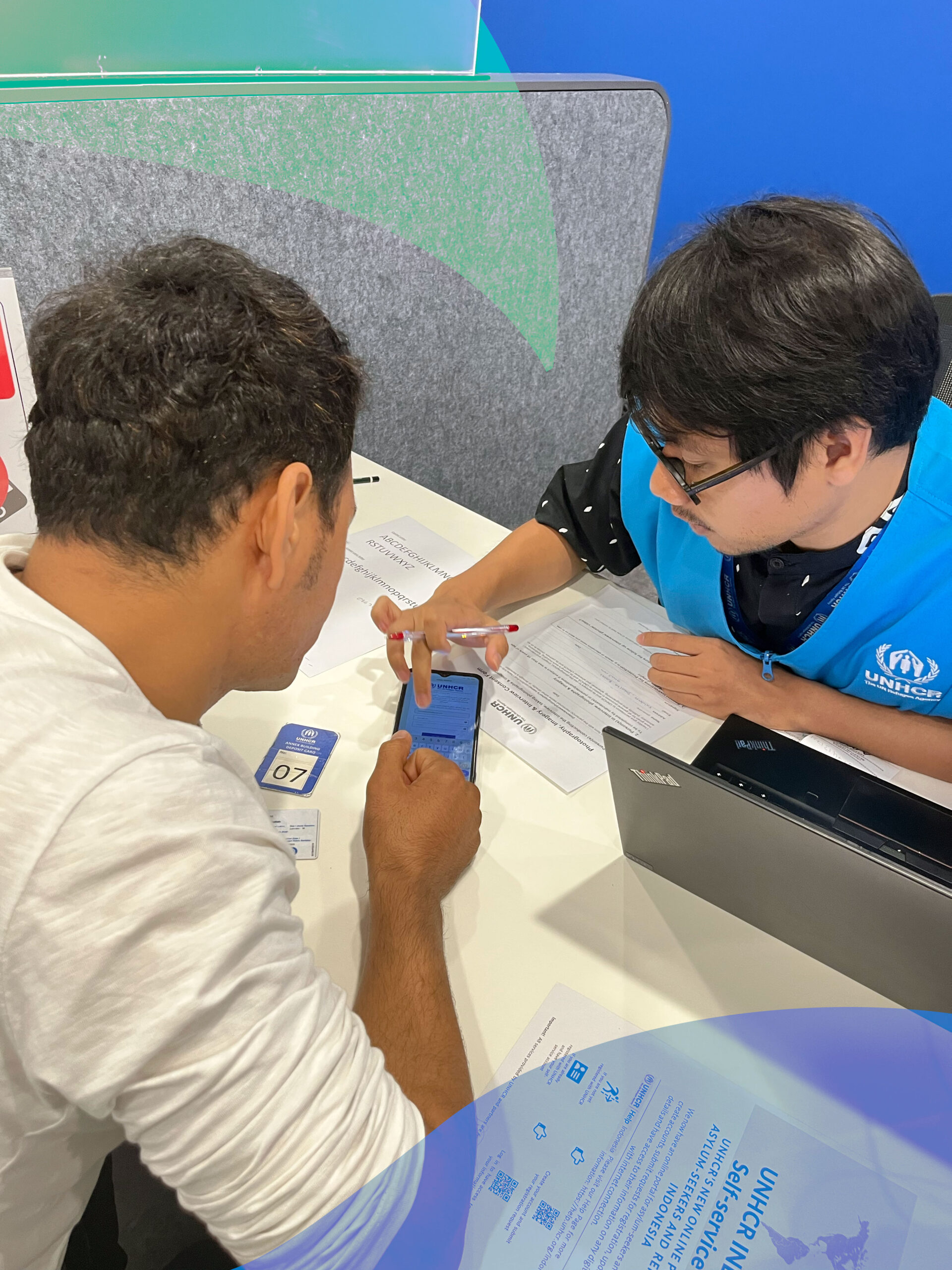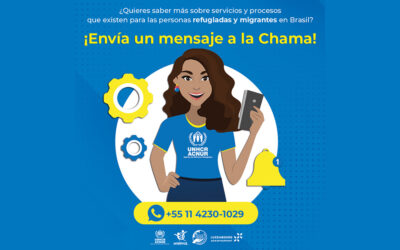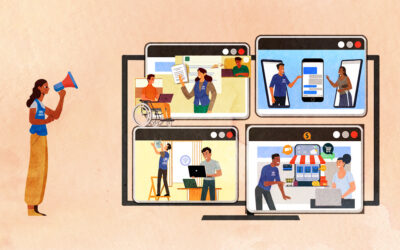
DIGITAL
GATEWAY
UNHCR’s Digital Gateway is set to transform the way communities interact with UNHCR, providing enhanced online access to crucial information, services and solutions.

Our goal is to offer a set of digital services and a smooth and unified communication experience, empowering forcibly displaced and stateless people through:
- Accessible protection services: Digital access to key services tailored for displaced and stateless communities.
- Multi-channel communication with communities: Engagement with UNHCR through communication channels such as websites, messaging apps, contact centres, kiosks, and social media.
- Effective feedback mechanisms: Feedback channels through various platforms, ensuring that communities’ voices are heard and can be acted upon.
- Enhanced access to solutions: Enabling forcibly displaced and stateless people to proactively learn about opportunities and solutions applicable to them, including education pathways, labour mobility schemes, and family reunification.
- Greater control of personal data: Increased control over their personal data held with UNHCR, enabling users to digitally exercise their rights as data subjects.
The Gateway is grounded in UNHCR’s commitments on Accountability to Affected People (AAP), as outlined in UNHCR’s Age, Gender, and Diversity Policy. These services are being delivered with inclusivity at the forefront, ensuring that they are appropriate and accessible to all groups in a community while building upon existing in-person services.

A Sudanese refugee interacts with her smartphone as she navigates the new onboarding tool provided by UNHCR. This digital tool empowers new arrivals to easily request a registration appointment. UNHCR/Pedro Costa Gomes.
The journey so far
Within the support provided to the US Government initiative, Safe Mobility, in the Americas, UNHCR, jointly with IOM, launched in 2023 the online portal Movilidad Segura. The portal allows individuals to create accounts and fill in questionnaires to apply for the programme. Eligible refugees and migrants are considered for humanitarian and other regular pathways to the US and other countries. Putting users at the heart of the project, the portal is also supported with a regional contact centre to allow portal users to reach UNHCR and IOM in relation to their queries and portal issues. The Safe Mobility programme has transformed processing for legal pathways in Americas.


An asylum-seeker creating her Movilidad Segura account. UNHCR/Ana Carolina Tome Pires
“My friend and I had already made travel arrangements to cross the Darien [the risky crossing between Colombia and Panama that people commonly take to reach the US irregularly], although I knew, from what I saw on social media, that bad things could happen to us on the journey. But when we managed to apply for the Movilidad Segura programme and received a call from UNHCR for the interview, we knew it was a true opportunity to give up on our plans and remain united with our families.”
– User in Ecuador
In May 2024, UNHCR also launched a self-service portal in Indonesia. The portal currently allows individuals to create accounts, update their contact information and check their resettlement case status. Refugees and asylum-seekers in Indonesia are spread out geographically among the many islands that make up the country, which makes it difficult for many to access UNHCR’s main office in Jakarta.
As we move forward with the project, UNHCR continues to listen to and learn from forcibly displaced and stateless people. This ensures they share ownership of this transformative initiative.
“I find the online self-service portal very useful for me and for many refugees. [Now] we don’t have to come all the way from where we live to find the latest update on our cases. It also helps us to upload important documents without having to personally submit them to the UNHCR office.”
– User in Indonesia
In August 2024, UNHCR launched a registration appointment booking tool in Egypt as part of our support for people forced to flee the conflict in Sudan. With this tool, Sudanese nationals can complete the pre-registration for themselves and their family members and request new registration appointments.
The tool has received overwhelmingly positive feedback from Sudanese arrivals, who no longer have to travel to UNHCR premises to book their appointments. The operation developed a package of communication tools to introduce the tool to the target population, including flyers with QR codes to the website, community meetings, and a step-by-step video guide in Arabic. The initiative has reduced the pressure on UNHCR’s main registration centres in Greater Cairo and Alexandria, improving the overall efficiency of the registration process. It is seen as a significant step forward in aiding Sudanese refugees, including new arrivals, to access asylum in Egypt.
A pillar of UNHCR’s digital transformation
The Digital Gateway is a flagship initiative under the ‘Digital Services’ priority outcome of UNHCR’s Digital Transformation Strategy. This project, which has been developed alongside other global digital tools like the PRIMES Interoperability Gateway, represents a major advancement in how UNHCR delivers protection and assistance, promoting greater accountability, transparency, and accessibility.
The Digital Gateway is a community-driven development. Since 2021, UNHCR has held extensive consultations with forcibly displaced and stateless communities worldwide. Detailed research has been carried out on the use of the existing digital services across different regions, challenges users have had in using and adopting to the use of digital services, and their thoughts on the various authentication methods, identity, security and data privacy.
Findings revealed a strong preference for digital self-service solutions, despite challenges related to connectivity and digital literacy in some regions, with many other valuable inputs on how we should develop a user-centric platform.
Of course, the digital landscape also brings with it risks for displaced and stateless people. UNHCR will continue to work in partnership with communities to monitor and address hate speech, misinformation, disinformation and online fraud, as well as to empower them to engage online with confidence.

UNHCR staff briefing a refugee on the Indonesia self-service portal. UNHCR/ Mitra Salima Suryono
Working in collaboration
For UNHCR, embarking on this journey is a demonstration of our commitment to transform the way we engage with the forcibly displaced, empower them by providing access to their data, and become more accessible in the digital realm. The Gateway will also facilitate better data for UNHCR to assess our impact, and to ensure evidence-based programming.
For Donors
Supporting the Digital Gateway will mean being part of the positive change initiated by UNHCR, which will enhance efficiency and effectiveness in service delivery, empower forcibly displaced and stateless people, and promote transparency through increased accuracy of data and accountability via reduced risk of fraud. With their contribution, donors will foster innovation and sustainability, while creating a positive public image by contributing to improved socio-economic outcomes and global stability by aiding forcibly displaced people’s empowerment.
For Governments
Supporting the Digital Gateway will mean improved administrative efficiency and accurate data management, reducing the burden on government agencies and ensuring fair resource allocation. The portal reduces the risk of fraud and promotes social stability by facilitating the integration of the forcibly displaced and stateless people. Additionally, it optimises resource use and potentially lowering costs.
For Partners
Using the Digital Gateway will mean improved collaboration and coordination, streamlined communication, and operational efficiency, allowing them to focus more on direct support. The platform enhances service delivery with personalised assistance and better access for forcibly displaced and stateless people, while ensuring greater transparency and accountability through accurate monitoring and reporting. Additionally, it reduces errors and fraud, optimises resource use, and enables scalable solutions, positioning partners as leaders in humanitarian innovation and increasing their impact and reach.

One of the UNHCR staff testing the new onboarding tool with a Sudanese refugee. This tool will enable new arrivals from Sudan to request a registration appointment with UNHCR on any digital device. UNHCR/Pedro Costa Gomes.
Join us in revolutionizing engagement and support for displaced and stateless people through the UNHCR’s Digital Gateway.
For more information, please contact:
Lea Bardakgi, Digital Gateway Project Coordinator, [email protected]
The strategy in action
One message at a time, La Chama chatbot combats falsehoods
To reduce misinformation among Venezuelan refugees and migrants in Boa Vista, Brazil, UNHCR launched the La Chama chatbot in 2021.
Leveraging technology to ensure water provision in refugee camps
To better monitor and ensure the timely delivery of water supplies to refugee camps in Uganda, UNHCR set up a digital monitoring system to receive real-time data on how water was being delivered and consumed across the country.
Enabling innovation and experimentation through UNHCR’s Digital Innovation Fund
To stimulate innovative approaches to digital technologies, UNHCR’s Digital Innovation Fund provides UNHCR colleagues with the support they need to deliver forward-thinking initiatives on digital inclusion, digital protection, and digital services.



